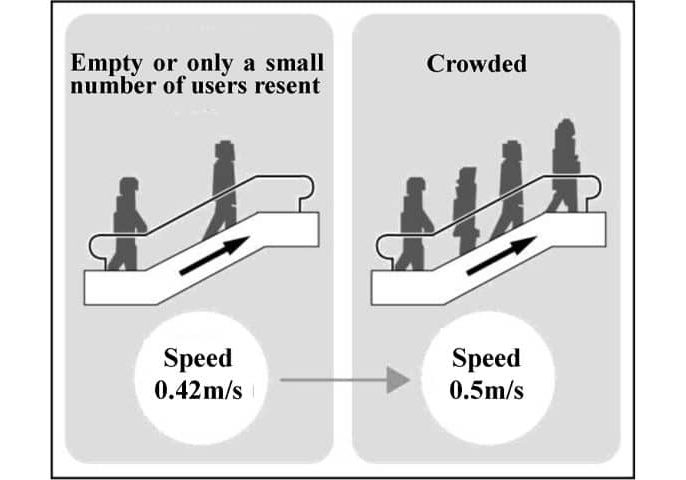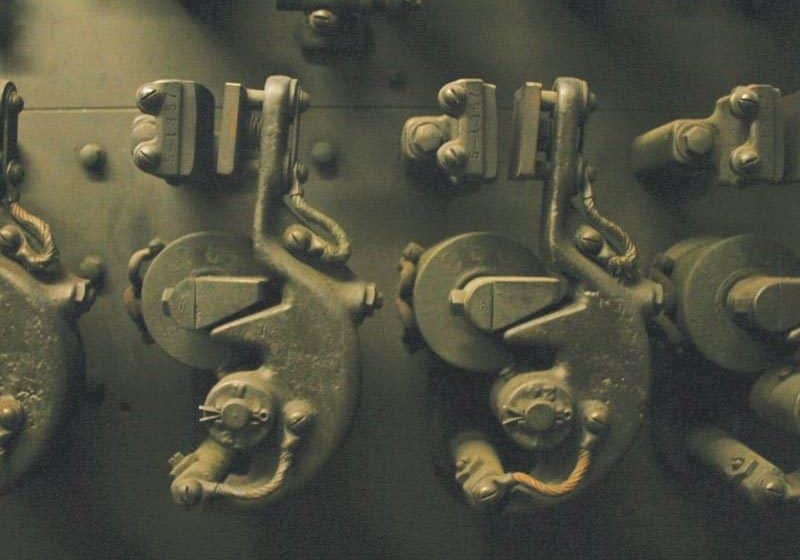This is the second article in a three-part series that examines movies that feature an elevator as a primary setting, rather than just as a prop that facilitates action. This month, four movies will be reviewed: De Lift (1983), Abwärts (1984), The Elevator (1996) and Down (2001). These films include two horror movies, one disaster movie and one comedy/ drama. Their respective plots built on past films such as Lady in a Cage (1964) and expanded the “role” that the elevator could play in movies.
De Lift was written and produced by well-known Dutch filmmaker Dick Maas. The plot centers on a bank of three elevators that are both the settings for action and active protagonists that interact with various characters. However, as this is a horror movie, the interactions are decidedly unpleasant: four passengers inexplicably suffocate in an elevator car after it stops between floors, a blind man falls down a shaft and a night watchman is decapitated. The elevator repairman is the hero who solves the mystery of the “killer lifts.” He discovers that the elevators are being controlled by a new (and clearly evil) system of microchips that, in addition to featuring innovative electronic components, also incorporates living organic material. The sentient controller apparently doesn’t like people – its inventor describes it as being “sick” – and, therefore, it has the occasional homicidal impulse.
De Lift was Maas’ first feature film, a fact that may explain the movie’s inconsistent quality and characterization by critics as a “B” horror film. However, the elevators, which featured bright red shaft doors and sinister red interior car lighting, are the movie’s leading characters. The film begins with a dramatic shot of an elevator car rising up a shaft. In addition to various scenes of elevator mayhem, there are several scenes in which, when the hall button is pushed, all three doors open simultaneously. Finally, in an almost balletic sequence, the three elevator doors alternately open and close as the evil controller attempts to lure a young child to her death. (Fortunately, she escapes unharmed.) Of course, some elevator scenes, such as when the hero climbs up the shaft to battle the evil elevator controller (in which he is struck several times by the passing car and miraculously survives with only cuts and bruises) are pure movie fantasy. The film was released in the Netherlands in May 1983, throughout Europe over the next two years and in the U.S. in July 1985.
Abwärts (released in the U.S. as Out of Order) is also a product of the European film industry. Produced and filmed in Germany, the movie followed the common “trapped in an elevator” story line. Unfortunately (at least for our industry), the elevator repairman is presented as the cause of the accident. Following a long day of working on the building’s lifts, the exhausted repairman leaves a screwdriver behind that falls down the shaft and pierces an unidentified electrical box, which brings the elevator to a halt between floors. The car has four passengers: a beautiful woman (Renée Soutendijk), her coworker and former lover (Götz George), a “violent young man” (Hannes Jaenicke, who is stealing money from a vending machine on an upper floor when we first see him) and an elderly accountant (Wolfgang Kieling, who has just stolen a large sum of money from his employer).
Naturally, neither the alarm button, nor emergency phone is functioning. The movie alternates between depicting the steadily rising tension among the passengers and various escape attempts. The latter begin with the removal of the fan in order to access the shaft. Following unsuccessful attempts to climb the elevator ropes, the passengers suddenly discover that the car has a storage closet that contains a fully equipped toolbox and a length of rope. These discoveries permit one last assault on the shaft. The failure of this attempt is followed by a fight that ends with the “violent young man” falling down the shaft. However, as he has the rope tied to his ankle (with the other end attached to the car’s roof), he survives the fall, climbs back up the shaft and reenters the car. This event coincides with the passengers’ discovery of the accountant’s theft and the building security guard’s realization that there are people stuck in an elevator.
The security guard contacts the elevator company, then races to the machine room, where he establishes communication with the trapped passengers and attempts to raise the car using the “emergency motor.” However, the various attempts to climb the shaft have damaged the top of the car such that, as the motor raises the car, it tilts and becomes wedged against the side of the shaft, and the additional strain causes the emergency motor to short circuit. At this point, the elevator repairmen arrive and attempt to raise the car by turning the hoisting sheave by hand. This effort ends with the car suddenly plunging down the shaft, stopping only when the emergency brakes are activated. The repairmen then conduct a rescue attempt in which they drop a rope and safety harness down to the car and begin to pull the passengers up to safety. During the rescue, the elevator cables begin to snap, one by one, until the car crashes to the bottom of the shaft just after the last passenger to be rescued has grasped the safety rope. Unfortunately, this passenger (George’s character) is also attempting to carry the accountant’s briefcase full of stolen money and, although he successfully passes the case up to the repairmen, in doing so, he losses his grip and falls to his death.
Abwärts was released throughout Europe between 1984 and 1986 and opened in the U.S. in November 1985. It received extensive critical acclaim and won numerous awards for best director (Carl Schenkel), cinematography and acting (George). It is an enjoyable movie that uses the elevator car, shaft and machine room to good effect and, in spite of several questionable depictions of elevator technology, is worth viewing.
The same cannot, however, be said about The Elevator (1996). In this American movie, the two main characters (a movie producer [Martin Landau] and an aspiring writer [David Brochman] are trapped in an elevator. The young writer reads several scripts to the producer in hopes of gaining employment, and as he reads each script, the elevator fades out, and the story is presented to the viewer. Thus, the movie is really a series of short films linked by repeatedly returning to interludes set in the elevator. Thus, the use of the elevator is limited to a static set piece, and the movie, which was never released theatrically and went straight to cable television, is terrible.
Down, filmed in the Netherlands and U.S., brings this month’s article full circle in that it was also directed and written by Maas and was, in essence, a big-budget remake of De Lift, with the story now set in New York City. The movie follows the same basic plot as the original (with a slight reshuffling of scenes and a few new additions) and featured an all-star cast that included James Marshall as the heroic elevator repairman and Naomi Watts as the inquisitive reporter seeking the true story behind the “killer elevators.” Once again, the truth is revealed to be an evil, part-electronic, part-organic sentient elevator control system that enjoys killing passengers. The movie features good special effects, makes excellent use of the full range of elevator settings (cars, shafts and the machine room) and is as enjoyable as the original. Down premiered at the 2001 Cannes Film Festival, after which it opened first in the Netherlands and then throughout Europe. However, in the U.S. – where it was released as The Shaft – the movie was never shown in theaters and, instead, had a “video premier” in May 2003.
Get more of Elevator World. Sign up for our free e-newsletter.










